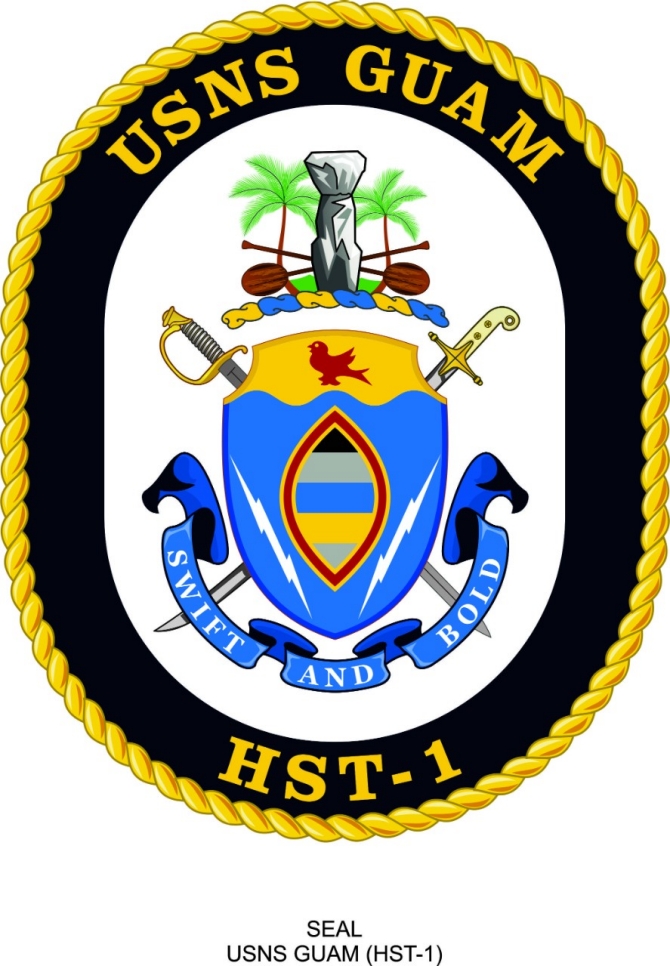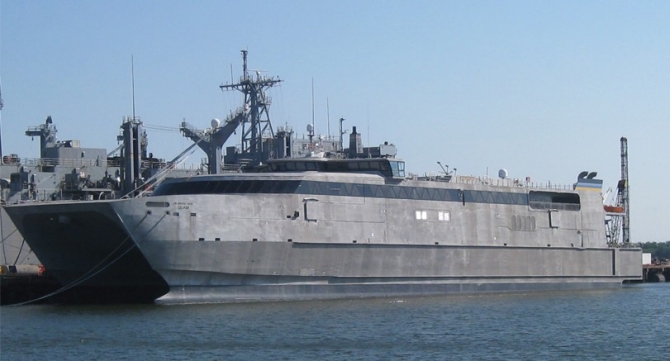Guam IV (T-HST-1)
The fourth U.S. Navy ship named for the largest island in the Marianas.
IV
(T-HST-1: displacement 2,437; length 373'; beam 78'; draft 14'; speed 33 knots; class Guam)
The fourth Guam (T-HST-1) was acquired as part of the National Defense Authorization Act for Fiscal Year 2012.

Shield
The colors of the shield, light blue, and yellow, are the colors of the Military Sealift Command (MSC). The central image is taken from the flag of Guam and depicts a throwing stone; the bars of color in the middle are the stack colors of the MSC fleet and reflect that Guam is part of that fleet. The lightning bolts represent speed and demonstrate that Guam is a high speed capable vessel. The wavy indicates that Guam is an island surrounded by the Pacific Ocean. The martlet is a mark of cadency signifying that she is the fourth U.S. Navy ship named after the island.
Crest
The headland and palm trees are taken from the flag of Guam and describe the tropical environment of the island. The paddles relate to the Chamorro legend of chief Gadao and his powerful paddling prowess. The latte stone is regarded as a symbol of tradition and strength, and served as foundation blocks for the thatch huts of the pre-contact ancient Chamorros. They are found in many parks and jungle areas of Guam.
Supporters
The swords symbolize cooperation and teamwork between the Navy and the Marine Corps, and the capability to transport all branches of the military and their vehicles.

On 6 April 2009, Secretary of Defense Robert M. Gates announced during a press conference concerning key defense budget recommendations that he intended to charter two additional high speed ferries in 2009–2011. The secretary explained that he planned to have the ships fill an operational gap in U.S. capabilities of transporting troops and their equipment to training areas from Okinawa and other locations, while awaiting the entry into service of further joint high speed vessels.
A magnitude 7.3 earthquake devastated Port-au-Prince, Haiti, killing an estimated 230,000 people, on 12 January 2010. The U.S. initiated Operation Unified Response to provide humanitarian aid to the victims. The ships that took part included two high speed vessels, Alakai and Huakai, which deployed under the operational control of the MSC. The Maritime Administration had taken possession of the two ships after their original owner, Hawaii Superferry, Inc., defaulted on loans that the administration had guaranteed. Powered by waterjet engines, the catamarans could each carry 288 cars and 866 passengers. Most of the ships involved came about from Haitian waters by 24 March, although relief efforts continued into the summer.
The Department of Transportation’s Maritime Administration announced on 27 January 2012 that it had transferred Alakai and Huakai to the Navy. The National Defense Authorization Act for Fiscal Year 2012 authorized the acquisition of the vessels, and the Navy provided $35 million to the Maritime Administration for them. They were berthed at Lamberts Point in Norfolk, Va.
On 9 May 2012, Secretary of the Navy Raymond E. Mabus announced that the ferries were renamed Puerto Rico (T-HST-2) and Guam, respectively. “High speed ferries will be used for peacetime operations such as troop transport training, exercise missions, and humanitarian and disaster relief,” Mabus explained. “I am pleased that Guam and Puerto Rico will serve as namesakes for these important additions to the fleet, in honor of their strong military heritage and our many shared values.”
Guam Delegate Madeleine Z. Bordallo in a statement said she personally received a phone call from Mabus about the ship. “The U.S. Navy has been integral to the history of Guam and remains an important presence in our community,” Bordallo said as she thanked Mabus for the recognition of the island. “The USNS Guam will help transport military personnel in the Asia-Pacific region and will likely be utilized to support operations in and around Guam in the coming years. Prior ships with this name have played important roles in the surrender of the Japanese forces during World War II and in Operation Desert Storm, and I am confident that this military transport high speed ferry will be a critical asset to the readiness of our forces in the Asia-Pacific region.”
Navy planners expected Guam to replace MSC-manned high speed vessel Westpac Express (HSV-4676), which provided high-speed transport for the III Marine Expeditionary Force. Guam required modifications to be able to fulfill her new role, however, including increasing her endurance by installing crew berthing, sewage treatment plants, and water-making equipment.
Detailed history pending.
Mark L. Evans
17 November 2015


